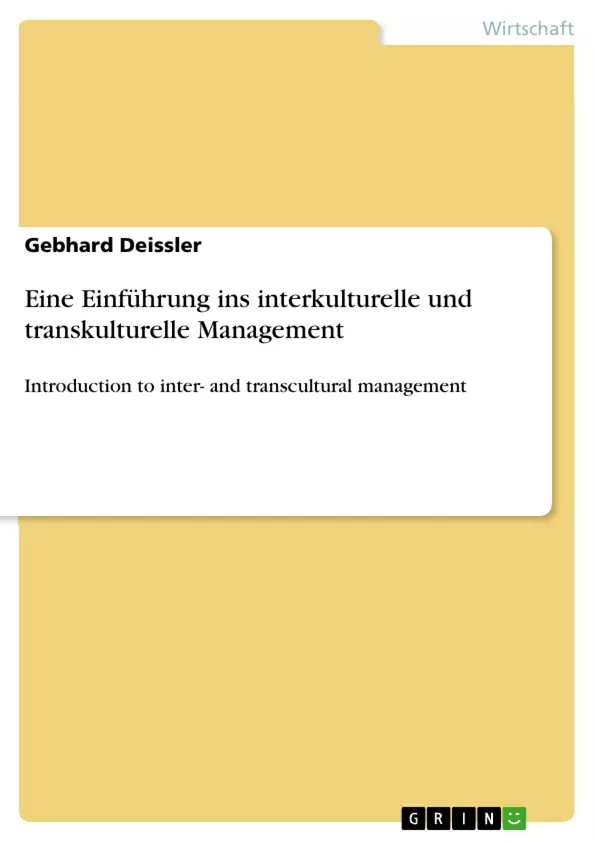Die Integration der kompelementären interkulturen/transkulturellen Kulturerkenntnis sind ein wissenschaftlich fundierter Ansatz für das Management der kulturellen Belange unseres Zeitalters im globalen Business ebenso wie in der Geopolitik und anderen Subsystemen des Planeten.
Inhaltsverzeichnis
- Struktur und Kultur des Menschen
- Kulturdefinition
- Die Entstehung des Kulturprofils
- Bewusstseinsarchitektur und Kultur
- Architektur der kulturellen Ebenen in verschiedenen Tiefen
- Die Beziehung zwischen expliziter und impliziter Bewusstseinsarchitektur
- THE STATE-OF-THE-ART OF INTERCULTURAL RESEARCH AND
MANAGEMENT – AND ITS FUTURE
- A synopsis of modern intercultural studies
- The transcultural profiler
- The epistemological foundation of the dynamic of the transcultural dimension
- Model for the management of the change of the intercultural paradigm
- THE TRANSCULTURAL PROFILER: THE UNIVERSAL CULTURE
MANAGEMENT MODEL
- Model, legend, explanations, correlations
- SYNOPSIS OF INTER-/TRANSCULTURAL MANAGEMENT INSTRUMENT
- INTER-/TRANSCULTURAL REFERENCE TERMINOLOGY INTER- AND TRANSCULTURAL REFERENCES
- Fazit
- Literaturverzeichnis
Zielsetzung und Themenschwerpunkte
Dieses Buch bietet eine umfassende Einführung in das interkulturelle und transkulturelle Management. Es zielt darauf ab, ein tiefes Verständnis für die kulturellen Unterschiede und Gemeinsamkeiten zwischen verschiedenen Gesellschaften zu vermitteln und praktische Werkzeuge für die erfolgreiche Zusammenarbeit in einem globalisierten Umfeld bereitzustellen.
- Die Bedeutung von Kultur für das Management
- Die Herausforderungen der interkulturellen Kommunikation
- Die Entwicklung eines transkulturellen Bewusstseins
- Modelle und Instrumente für das interkulturelle Management
- Die Zukunft des interkulturellen und transkulturellen Managements
Zusammenfassung der Kapitel
Das erste Kapitel beleuchtet die Struktur und Kultur des Menschen. Es definiert Kultur als ein Produkt der Wechselwirkung zwischen Individuen und ihrem Umfeld und untersucht die Entstehung des Kulturprofils. Die Bewusstseinsarchitektur und die verschiedenen kulturellen Ebenen werden analysiert, um die Beziehung zwischen expliziter und impliziter Kultur zu verstehen.
Das zweite Kapitel befasst sich mit dem aktuellen Stand der interkulturellen Forschung und des Managements. Es gibt einen Überblick über moderne interkulturelle Studien, stellt den transkulturellen Profiler vor und untersucht die epistemologischen Grundlagen der transkulturellen Dimension. Schließlich wird ein Modell für das Management des Wandels des interkulturellen Paradigmas vorgestellt.
Das dritte Kapitel präsentiert den transkulturellen Profiler als ein universelles Kulturmanagementmodell. Es erläutert das Modell, seine Legende, Erklärungen und Korrelationen.
Das vierte Kapitel bietet eine Zusammenfassung des Instruments für das inter-/transkulturelle Management.
Das fünfte Kapitel stellt eine Referenzterminologie für das inter-/transkulturelle Management bereit.
Schlüsselwörter
Die Schlüsselwörter und Schwerpunktthemen des Textes umfassen Kultur, Interkulturelles Management, Transkulturelles Management, Kulturunterschiede, Kulturvergleich, Globalisierung, Kommunikation, Bewusstseinsarchitektur, transkultureller Profiler, Kulturmanagement, interkulturelle Kompetenz, transkulturelle Kompetenz, interkulturelle Kommunikation, transkulturelle Kommunikation, interkulturelle Zusammenarbeit, transkulturelle Zusammenarbeit.
- Quote paper
- D.E.A./UNIV. PARIS I Gebhard Deissler (Author), 2011, Eine Einführung ins interkulturelle und transkulturelle Management, Munich, GRIN Verlag, https://www.grin.com/document/181862



